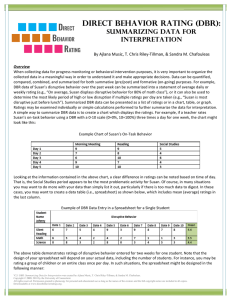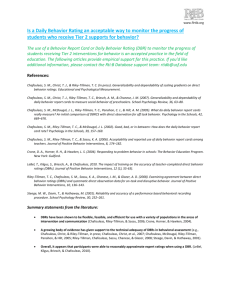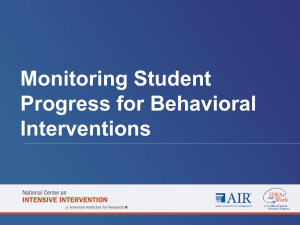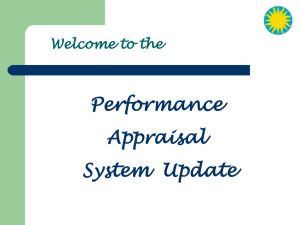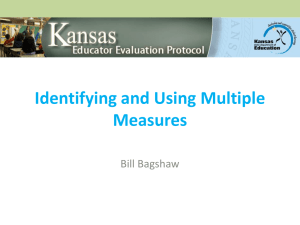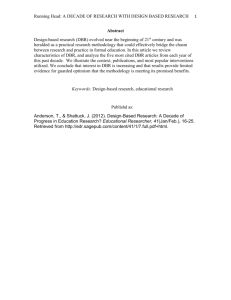(DBR): Tools for Progress Monitoring within Multi
advertisement
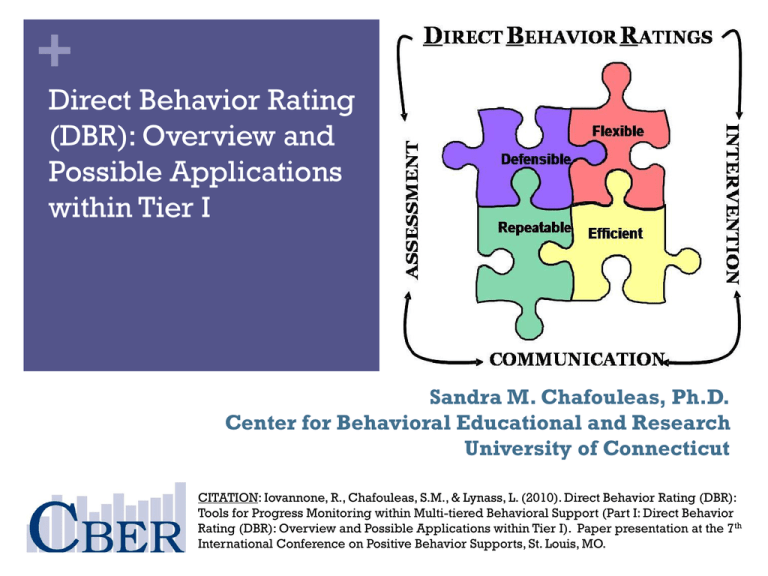
+ Direct Behavior Rating (DBR): Overview and Possible Applications within Tier I Sandra M. Chafouleas, Ph.D. Center for Behavioral Educational and Research University of Connecticut CITATION: Iovannone, R., Chafouleas, S.M., & Lynass, L. (2010). Direct Behavior Rating (DBR): Tools for Progress Monitoring within Multi-tiered Behavioral Support (Part I: Direct Behavior Rating (DBR): Overview and Possible Applications within Tier I). Paper presentation at the 7th International Conference on Positive Behavior Supports, St. Louis, MO. + My Purpose: To introduce Direct Behavior Rating (DBR) as an assessment method for progress monitoring of student behavior To review options for use of DBR in Tier I assessment purposes + Overview of DBR in Assessment: History & Defining Features + BRIEF REVIEW: Why do we need data? Purposes of Assessment Screening Progress Monitoring Diagnosis Evaluation Emphasized within a problemsolving framework + What is “problem-solving framework”? Two Basic Questions: How do we know X is a “problem”? How do we know if Y is an effective strategy for “handling” X? What is the problem? Why is it occurring? What should we do about it? Did it work? (Bergan, 1977, Bergan &Kratochwill, 1990; Tilly, 2009; Reschly& Bergstrom, 2009) + What are desirable features of assessment tools within PSM? Defensible established by methods useful in guiding a variety of assessment questions and situations Efficient Measurement Concerns Feasibility Concerns Type of Assessment Time Measurement Targets Staff Resources Psychometric Properties Obtrusiveness Flexible established through psychometric research to provide evidence of reliability and validity for interpretation and use established by methods that require relatively few resources (feasible and reasonable) Repeatable established by methods that yield necessary time series to evaluate intervention effectiveness Source: Chafouleas, Riley-Tillman, & Christ, 2009; Chafouleas, RileyTillman, & Sugai, 2007; Christ, Riley-Tillman, & Chafouleas, 2009) Adapted from Briesch & Volpe (2007) + BUT for behavior, it’s not so simple… Possible Methods: Systematic direct observation Traditional behavior rating scales Permanent products (ODR) Direct Behavior Rating + DIRECT BEHAVIOR RATING : What is DBR? An emerging alternative to systematic direct observation and behavior rating scales which involves brief rating of target behavior following a specified observation period Chafouleas, Riley-Tillman, & Christ (2009); Chafouleas, Riley-Tillman, & Sugai (2007); Chafouleas, Riley-Tillman, & McDougal (2002); Christ, Riley-Tillman, & Chafouleas (2009) + A little background… Other Names for DBR-like Tools: Home-School Note Behavior Report Card Daily Progress Report Good Behavior Note Check-In Check-Out Card Performance-based behavioral recording Contemporary Defining Features: SDO BRS Used repeatedly to represent behavior that occurs over a specified period of time (e.g., 4 weeks) and under specific and similar conditions (e.g., 45 min. morning seat work) + Direct Behavior Rating Direct establishes that the observation and rating occur at the time and place that behavior occurs. This minimizes inference & retrospective judgments + Direct Behavior Rating Behavior the target of assessment must be accessible for observation and evaluation by the intended rater. the preference is to observe behavior within the naturalistic setting. contents/modalities for behavioral assessment are motor, physiological, and cognitive (Cone, 1978). + Direct Behavior Rating Rating quantify a person’s perception or attitude toward something. DBR can be compared to any of a variety of other problem solving and behavioral assessments SDO Interviews behavioral rating scales Inference High + Direct Behavior Rating & Other Methods High Inference Shorter Latency High Inference Longer Latency Anecdotal Narrative Unstructured Interviews Permanent Product from Office Referrals Semi-structured Interviews Direct Behavior Rating Low Systematic Direct Observation Behavior Rating Scales Permanent Product from a Token Economy Low Inference Shorter Latency Shorter Low Inference Longer Latency Longer Latency Source: Christ, Riley-Tillman, & Chafouleas (2009) Example Scale Formats for DBR Source: Chafouleas, Riley-Tillman, & Christ (2009) + Project VIABLE: Validation of Instruments for Assessing Behavior Longitudinally &Efficiently GOAL: Develop and Evaluate DBR Phases I & II: Develop instrumentation and procedures; evaluate defensibility of DBR in decision-making • Large datasets; repeated observations of student behavior • Understanding critical factors (e.g. scale format, behavior targets, training requirements) • Pilot testing various aspects with classroom teachers Phase III: Evaluate feasibility and utility of DBR in school settings. • Packaging what we have learned to then train teachers • Establish groups of teachers/schools willing to participate in DBR training and use • Evaluate data/feedback Sandra M. Chafouleas T. Chris Riley-Tillman Theodore J. Christ George Sugai Funding provided by the Institute for Education Sciences, U.S. Department of Education (R324B060014). + DBR – Single Item Scale Ratings should correspond to the percentage of time that the student was observed to display the target behavior. Ex: When rating after 40-minute Independent Reading Block, if the student was engaged for 20 minutes, then the student receives a rating of 5 on the DBR. Academically Engaged Never Always 40 minutes + Key Pieces to using DBR-SIS: Have the rating ready (date, name). Complete rating immediately following the activity period. Skip rating if you did not observe for a sufficient amount of time. Ratings should correspond to the proportion of time that you actually observed the student display the target behavior. When rating, each behavior should be considered independently of the other targets. That is, total ratings across behaviors do not have to equal 100%. For example, a student may be engaged 50% of the time, and disruptive 20%. A student may also be engaged for 100% of the time, and disruptive for 10%. + Which targets do I rate using DBR-SIS? Academic Engagement: Actively or passively participating in the classroom activity. Respectful: Compliant and polite behavior in response to adult direction and/or interactions with peers and adults. Academically Engaged KEYS TO SUCCESS Respectful Disruptive Behavior: A student action that interrupts regular school or classroom activity. NonDisruptive + Current Forms: www.directbehaviorratings.com + Application of DBR-SIS in Tier I: Examples and Considerations + Possibilities… Progress Monitoring Assessment of a “group” Small group, classwide Universal Screening Assessment for Early Identification of Risk Individual focus + Case Study Example: Classwide Assessment Riley-Tillman, Methe, & Weegar (2009) Sample: First grade classroom with 14 students Design: B-A-B-A Intervention: modeling and prompting of silent reading Measures: researcher-completed SDO, teacher-completed DBR-SIS Conclusion: DBR data can be sensitive to classroom-level intervention effects, maps closely to resource-intensive SDO DBR SDO B1 72 68 Phase Mean A1 B2 45 63 49 61 A2 42 50 + Example: Early Identification and Monitoring using “Local” Norms Chafouleas, Kilgus, & Hernandez (2009) Sample: full day K inclusive classroom, 2 teachers and 22 students Measures: teacher-completed DBRSIS following am and pm over NovMarch for ALL students Conclusion: “Local” cut-score comparisons can be useful in examining individual student performance. Periodic reassessment of all may be needed to re-confirm appropriate comparison Target Behavior Academic Engagement Disruptive Behavior Rating Time AM PM AM PM FALL M (SD) 8.72 (1.31) 8.25 (2.03) 1.30 (1.47) 1.61 (2.08) SPRING M (SD) 9.40 (0.63) 9.37 (0.88) 0.60 (0.62) 0.42 (0.52) + Example: Early Identification using Condition Example DBR-SIS with BESS Criterion “Cut-Points”(est. via the “gold standard”) Kilgus, Chafouleas,Positive RileyTillman, & Welsh (in prep) Test Positive TRUE Pos. Purpose: To evaluate the diagnostic Outcome accuracy of all possible DBR-SIS (Disruptive Behavior, Academic Engagement, Compliance) Negative FALSE Neg. Sample: Second grade teachers and (Type II error) randomly selected students in their classrooms Measures: teacher-completed DBR-SIS following am and pm over=1Sensitivity week, BESS and SSiS Performance Screener Analyses: Diagnostic accuracy statistics Conclusion: DBR may provide efficient initial identification of potential risk, but may need to be confirmed through complementary measures. Findings suggest interpretation of DBR-SIS “cutscore” may be highly dependent on what is considered to be a “true” indicator of school-based behavioral difficulty. Target Negative Cut SS SP Behavior Score .917 .615 FALSE Pos. 1.210 = Pos. predictive Disruptive (Type I error) 1.530 value.875 .698 Behavior 1.580 .833 .698 .792 .771 TRUE Neg. 1.845 = Neg. predictive 7.165 value.792 .844 Academic 7.365 .833 .823 Engagement 7.895 .875 .771 = Specificity 8.055 .917 .719 8.410 .958 .677 PPP NPP .373 .420 .408 .463 .559 .541 .488 .449 .426 .967 .957 .944 .937 .942 .952 .961 .972 .985 + Questions & Comments… Contact: Dr. Sandra Chafouleas sandra.chafouleas@uconn.edu www.directbehaviorratings.com www.cber.org
